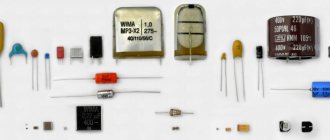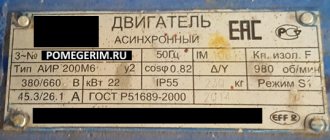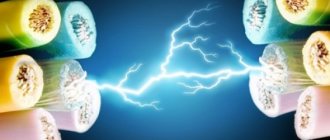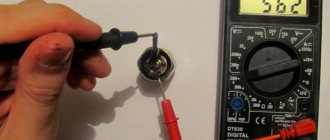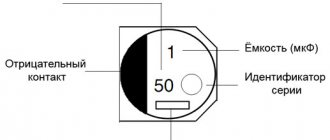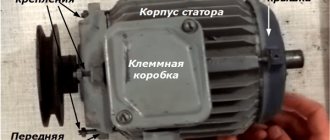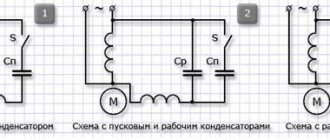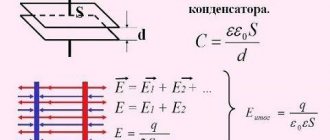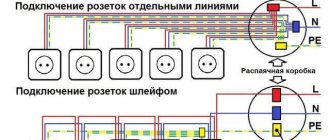Electric motor power calculation
Calculation of electric motor power by current can be done using our online calculator:
The result obtained can be rounded to the nearest standard power value.
Standard values of electric motor power : 0.25; 0.37; 0.55; 0.75; 1.1; 1.5; 2.2; 3.0; 4.0; 5.5; 7.5; eleven; 15; 18.5; 22; thirty; 37; 45; 55; 75 kW, etc.
Engine power is calculated using the following formula:
P=√3UIcosφη
- U - Rated voltage (voltage to which the electric motor is connected);
- I - Rated current of the electric motor (taken from the passport data of the electric motor , and in their absence is determined by calculation);
- cosφ - Power factor - the ratio of active power to total power (taken from 0.75 to 0.9 depending on the power of the electric motor);
- η - Efficiency factor - the ratio of the electrical power consumed by the electric motor from the network to the mechanical power on the motor shaft (taken from 0.7 to 0.85 depending on the power of the electric motor);
What is a capacitor
The capacitor consists of two plates located opposite each other. A dielectric is placed between them. Its task is to remove polarization, i.e. charge of nearby conductors.
There are three types of capacitors:
- Polar. It is not recommended to use them in systems connected to AC power, because Due to the destruction of the dielectric layer, the device heats up, causing a short circuit.
- Non-polar. They work in any switching mode, because their plates interact equally with the dielectric and with the source.
- Electrolytic (oxide). A thin oxide film acts as electrodes. They are considered an ideal option for low-frequency electric motors, because... have the highest possible capacity (up to 100,000 µF).
Motor current calculation
The rated and starting current of an electric motor can be calculated by power using our online calculator:
The rated motor current is calculated using the following formula:
Inom=P/√3Ucosφη
- P - Rated power of the electric motor (taken from the motor’s passport data or determined by calculation);
- U - Rated voltage (voltage to which the electric motor is connected);
- cosφ - Power factor - the ratio of active power to total power (taken from 0.75 to 0.9 depending on the power of the electric motor);
- η - Efficiency factor - the ratio of the electrical power consumed by the electric motor from the network to the mechanical power on the motor shaft (taken from 0.7 to 0.85 depending on the power of the electric motor);
The starting current of the electric motor is calculated using the formula:
Istart=Inom* K
- K - Starting current multiplicity, this value is taken from the electric motor passport, or from catalog data (in the above online calculators, the starting current multiplicity is determined approximately based on the other specified characteristics of the electric motor).
Connecting starting and running capacitors for a three-phase electric motor
Here is the correspondence of all the necessary devices to the elements of the circuit
Now let's make the connection, carefully understanding the wires
This way you can connect the engine both preliminary, using an inaccurate estimate, and finally, when the optimal values are selected.
The selection can also be made experimentally, having several capacitors of different capacities. If they are connected in parallel to each other, the total capacity will increase, and you need to watch how the engine behaves. As soon as it starts to work smoothly and without overload, it means that the capacity is somewhere in the optimum area. After this, a capacitor is purchased with a capacity equal to this sum of the capacitances of the capacitors being tested connected in parallel. However, with such a selection, it is possible to measure the actual current consumed using a current clamp, and calculate the capacitance of the capacitor using the formulas.
Calculation of electric motor power factor
Online calculation of power factor (cosφ) of an electric motor
Calculation of cosφ (cosine phi) of the engine is carried out using the following formula:
cosφ=P/√3UIη
- P - Rated power of the electric motor (taken from the motor’s passport data or determined by calculation);
- U - Rated voltage (voltage to which the electric motor is connected);
- I - Rated current of the electric motor (taken from the passport data of the electric motor , and in their absence is determined by calculation);
- η - Efficiency factor - the ratio of the electrical power consumed by the electric motor from the network to the mechanical power on the motor shaft (taken from 0.7 to 0.85 depending on the power of the electric motor);
Capacitor Characteristics
The main characteristic of this element is capacitance, or C. It determines the ability of the device to collect electrical charge, depends on the geometric configuration of the covers and on the electrical constant of the dielectric between the covers.
Important! The capacitance depends on the type of dielectric used, as well as on the geometric dimensions of the element. In order to describe the principle of operation of the device with a formula, it is necessary to understand that this is a constant proportionality in the equation, which represents the mutual dependence of the accumulated charge q on the area of the plates and on the potential difference V between them
In order to describe the principle of operation of the device with a formula, it is necessary to understand that this is a constant proportionality in the equation, which represents the mutual dependence of the accumulated charge q on the area of the plates and on the potential difference V between them.
You may be interested in this Features of free energy
Power is expressed in units called farads F. But in practice smaller units such as microfarads and picofarads are also used.
Appearance of devicesThus, if a voltage U is applied to a capacitor, an electric charge accumulates on the caps of the part. The value of the accumulated charge on each plate is the same, they differ only in sign. This process of accumulation of electrical indicator is called charging.
Another parameter of the part is the rated voltage, namely, its maximum value that can be supplied to the capacitor. When a higher voltage is connected, dielectric breakdown occurs. This causes the element to short circuit. What the nominal voltage value will be depends on the type of dielectric and its thickness.
Important! The thicker the dielectric, the higher the rated voltage it can withstand. Legend
Legend
Another parameter is the leakage current - the value of the conductive indicator that occurs when a constant voltage is applied to the ends of the element.
Calculation of electric motor efficiency
Online calculation of efficiency (efficiency) of an electric motor
The efficiency of the electric motor is calculated using the following formula:
η=P/√3UIcosφ
- P - Rated power of the electric motor (taken from the motor’s passport data or determined by calculation);
- U - Rated voltage (voltage to which the electric motor is connected);
- I - Rated current of the electric motor (taken from the passport data of the electric motor , and in their absence is determined by calculation);
- cosφ - Power factor - the ratio of active power to total power (taken from 0.75 to 0.9 depending on the power of the electric motor);
Did you find these online calculators useful? Or maybe you still have questions ? Write to us in the comments!
Didn’t find an article on the website on a topic that interests you regarding electrical engineering? Write to us here. We will definitely answer you.
Practical use
Power drives will only operate correctly if their starting characteristics are taken into account when selecting them.
High starting current poses a serious danger to electrical equipment. If measures are not taken to limit it, serious problems are possible.
The starting current can damage not only the motor itself, but also other electrical equipment installed on the same line with it. To solve this problem, you can use the following methods:
In = Pн/(√3Uн x сosφ), kA
where Pn is the rated power of the engine, kW, Un is the network voltage, kV (0.38 kV). Power factor (cosφ) – engine nameplate values.
Rice. 1. Electric motor passport.
If the power factor of the motor is not known, then its rated current with a small error is determined by the ratio “two amperes per kilowatt,” i.e. If the rated power of the motor is 10 kW, then the current it consumes from the network will be approximately 20 A.
For the motor mentioned in the figure, this ratio also holds (3.4 A ≈ 2 x 1.5). More accurate current values when applying this ratio are obtained with electric motor powers of 3 kW and above.
When the electric motor is idling, a small current is consumed from the network (no-load current). As the load increases, the current also increases. As the current increases, the heating of the windings increases. Large overload leads to overheating of the motor windings, and there is a risk of failure of the electric motor.
When starting from the network, the electric motor consumes a starting current Istart, which is 3 to 8 times higher than the rated current. The characteristic of the current change is presented on the graph (Fig. 2, a).
Rice. 2. Characteristics of changes in the current consumed by the electric motor from the network (a), and the effect of high current on voltage fluctuations in the network (b)
actual value of the starting current for an electric motor is determined by knowing the magnitude of the starting current multiplicity - Istart/Inom. The starting current multiplicity is a technical characteristic of the engine, it is known from catalogs. The starting current is calculated according to the formula: I start = Ix. x (Istart/Inom).
Understanding the true value of the starting current is necessary for selecting fuses, checking the activation of electromagnetic releases during engine starting, when selecting circuit breakers, and for calculating the magnitude of the voltage drop in the network during start-up.
A large starting current causes a significant voltage drop in the network (Fig. 2, b).
If we take the electrical resistance of the wires laid from the source to the electric motor equal to 0.5 Ohm, the rated current Iн = 15 A, and the starting current Iп equal to five times the rated one, the voltage loss in the wires during starting will be 0.5 x 75 + 0.5 x 75 = 75 V.
At the terminals of the electric motor, as well as at the terminals of nearby operating electric motors, the voltage will be 220 - 75 = 145 V. This decrease in voltage causes braking of the operating electric motors, which entails an even greater increase in the current in the network and failure of the fuses.
In electric lamps, when electric motors start, the intensity decreases (the lamps “blink”). Therefore, when turning on electric motors, they strive to reduce starting currents .
To reduce the starting current, an electric motor starting circuit is used with switching the stator windings from star to delta.
Rice. 3. Scheme for starting an electric motor with switching the stator windings from star to delta.
It is of fundamental importance that not every engine can be switched on according to this scheme. Widespread asynchronous motors with an operating voltage of 220/380 V, including the motor shown in Figure 1, will fail when switched on according to this circuit.
Why is it necessary to know energy?
In most cases of using capacitances in electrical circuits, the concept of energy is not used.
This especially applies to time- and frequency-setting circuits and filters. But there are areas where it is necessary to use energy storage devices. The most striking example is photographic flashes. In the storage capacitor, the energy of the power source accumulates relatively slowly - a few seconds, but the discharge occurs almost instantly through the electrodes of the flash lamp. A capacitor, like a battery, stores electrical charge, but there are many differences between these elements. The capacity of a battery is incomparably higher than that of a capacitor, but the latter is capable of releasing it almost instantly. Only recently, with the advent of ionistors, this difference has been somewhat smoothed out.
Ionistor
What is the approximate energy value? As an example, you can calculate it for the already mentioned flash. Let the supply voltage be 300 V, and the storage capacitor capacity be 1000 μF. When fully charged, the energy value will be 45 J. This is quite a large amount. Touching the terminals of a charged element may cause an accident.
Flash capacitor
Important! Forced discharge by short-circuiting the terminals with metal objects can result in device failure. The accumulated energy of a capacitor can melt the leads inside the element in a split second and damage it.
Electric motor power calculation
The conversion of electrical energy into kinetic energy is carried out using various types of electric motors. These devices are widely used in modern production and in everyday life. Most often, electric motors serve as electric drives for machines and mechanisms and are used to ensure the operation of pumping equipment, ventilation systems and many other units and devices. In connection with such a wide application, the calculation of electric motor power is of particular relevance. For these purposes, many different methods have been developed that allow calculations to be performed in relation to specific operating conditions.
What is leakage current and what are the reasons for exceeding the charge leakage rate?
Leakage current is a quantity that characterizes the process of reducing the battery capacity due to both natural causes and malfunctions in the electronics of the machine or improper operation of electrical appliances.
In the worst case, the car may not start at all if the battery is completely dead, but this situation can only happen if there are serious malfunctions or some electricity consumers are left in working condition overnight. If the car owner makes it a rule to check whether power consumers are turned off, it is likely that major troubles will be avoided.
Leakage is a normal process, but there is a normalized leakage value that is allowed by the manufacturer. Most often, the norm ranges from 15-20 to 50 mA. On modern cars with a large number of consumers, this parameter may be higher.
You can measure the leakage current using a standard open-end wrench and a multimeter. Also remember to wear gloves. The algorithm of actions is as follows:
- turn off all consumers, including the DVR and anti-theft alarm;
- disconnect the negative terminal from the battery;
- connect a multimeter measuring current to the battery negative and the negative terminal;
- Compare the readings with the norm for your model.
Source: www.kolesa-darom.ru
Main types of electric motors
There are many types and modifications of electric motors. Each of them has its own power and other parameters.
The main classification divides these devices into DC and AC motors. The first option is used much less frequently, since its operation requires the presence of a direct current source or a device that converts alternating voltage into direct current. Fulfilling this condition in modern production will require significant additional costs.
But, despite significant disadvantages, DC motors have a high starting torque and operate stably even at high overloads. Due to their qualities, these units are widely used in electric transport, in the metallurgical and machine tool industries.
However, most modern equipment runs on AC motors. The operation of these devices is based on electromagnetic induction, which is created in a magnetic field by a conducting medium. The magnetic field is created using windings flowing around currents or using permanent magnets. Electric motors operating on alternating current can be synchronous or asynchronous.
The use of synchronous electric motors is practiced in equipment where a constant rotation speed is required. These are DC generators, pumps, compressors and other similar installations. Different models differ in their own technical characteristics. For example, the rotation speed can be in the range of 125-1000 rpm, and the power reaches 10 thousand kilowatts.
Many designs have a short-circuited winding located on the rotor. With its help, if necessary, an asynchronous start is made, after which the synchronous motor continues to operate as usual, minimizing electrical energy losses. These engines are characterized by their small size and high efficiency.
Asynchronous AC motors have become much more widespread in the manufacturing sector. They are characterized by a very high frequency of rotation of the magnetic field, significantly exceeding the speed of rotation of the rotor. A significant disadvantage of these devices is considered to be a decrease in efficiency to 30-50% of the norm at low loads. In addition, during start-up, the current parameters become several times greater compared to operating indicators. These problems are eliminated by using frequency converters and soft starters.
Asynchronous motors are used in those facilities where frequent switching on and off of equipment is required, for example, in elevators, winches, and other devices.
What is a capacitor?
A capacitor consists of two conducting plates located very close to each other and separated by a dielectric. Applying a constant voltage to the plates will cause current to flow and the appearance on both covers of charges equal in magnitude, but opposite in sign: negative on one and positive on the other. Disabling the power source will result in the charge not disappearing instantly, ignoring the phenomenon of its gradual leakage. Then, if the part covers are connected to some kind of load, for example, to a flash, the capacitor will discharge itself and return all the energy accumulated in it to the flash.
Capacitor designation
Capacitors are passive components that store electrical charge. This simple function is used in various cases:
- With alternating current.
- At constant current.
- In analog networks.
- In digital circuits.
Examples of using devices: synchronization systems, signal shaping, communications, filtering and signal smoothing, setting up televisions and radios.
Calculation of electric motor power for a pump
The choice of electric motor for a pumping installation depends on specific conditions, first of all, on the water supply scheme. In most cases, water is supplied using a water tank or a water boiler. Centrifugal pumps with asynchronous motors are used to drive the entire system.
The selection of the optimal pump power is carried out depending on the need for fluid supply and pressure. The QH pump flow is measured in liters delivered per hour and is designated as l/h. This parameter is determined by the following formula: Qn = Qmaxch = (kch x kday x Qav.day) / (24 η), where Qmaxch is the possible maximum hourly water flow rate, l/h, kch is the coefficient of unevenness of hourly flow, kday is the coefficient of unevenness daily flow rate (1.1 - 1.3), η - efficiency of the pumping unit, taking into account water losses), Qavg.day - value of the average daily water flow rate (l/day).
